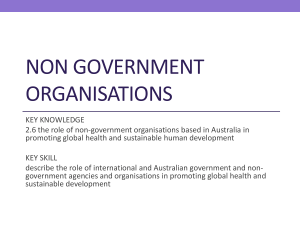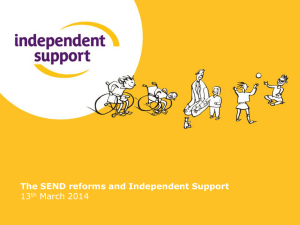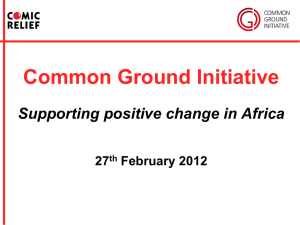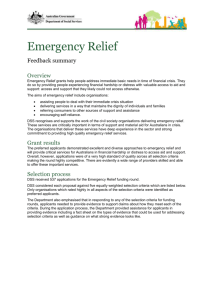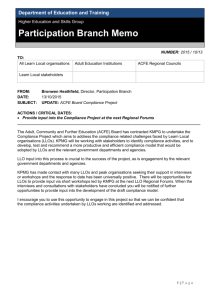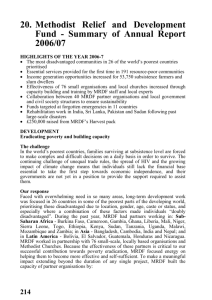Giving Shape to the Emergency Relief Sector
advertisement
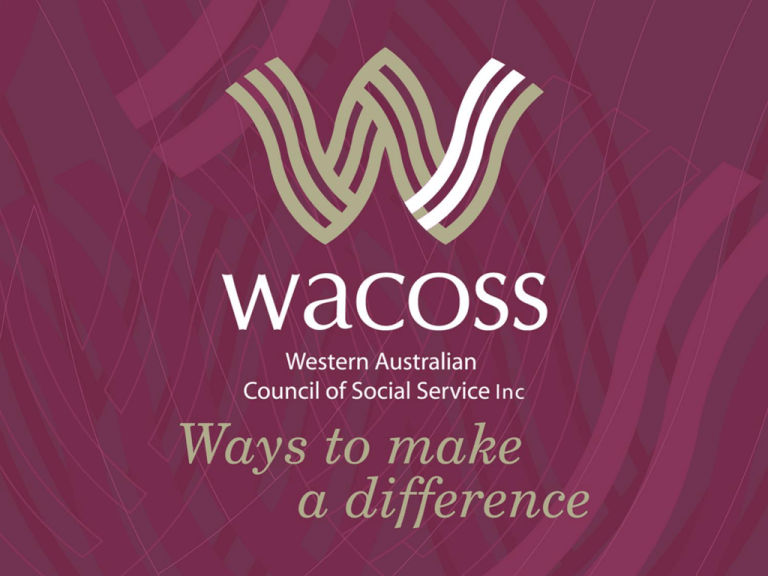
Giving Shape to the ER sector 2013 divERsity Conference Presented by Irina Cattalini, WACOSS CEO Scoping Study of ER • March to July 2012 WACOSS project to scope the Emergency Relief Sector - funded by Lotterywest • Objectives of the Study: 1. Define the ER sector in WA 2. Identify the ways the sector is meeting the increasingly complex needs of service users Scoping Study of ER Objectives of the Study(continued) 3.Identify the resources being used to meet ER need across the State 4.Identify how ER services can best complement the financial counselling, financial assistance and financial literacy programs and services being funded by DCP and FaHCSIA 5.Identify the capacity building and resources required to sustain the ER sector Research Methodology • There were 66 face to face consultations undertaken with services • Interviews with organisations in Perth, Albany, Manjimup, Broome, Geraldton, Karratha, Corrigin, Bunbury, Northam and Kununurra • An online survey of 26 other service providers • Data analysis and report finding by WACOSS staff, with input from SERC Identified Organisations Delivering ER Services • • • • • • Small Church-located ER services ER outlets of large faith based organisations Multi-program organisations Medium sized multi-program organisations Large regional, multi-program organisations Large faith based organisations Identified Organisations Delivering ER Services • Not soup kitchens or mobile food distribution services • The project could only identify one ER service in Perth that operates over the weekend and only south of the river. • Crisis Care - Department for Child Protection - limited ER service after hours and at weekends - assist the homeless, or those in domestic violence situations. All other ER requests are referred out. ER Referrals The three agencies most frequently making referrals to ER providers are: 1) Other ER Agencies 2) Centrelink 3) Department of Child Protection The three agencies ER providers most frequently refer to are: 1) Financial Counsellors 2) ER Providers 3) Accommodation providers ER Referrals- the challenges Challenges: • Not enough services and programs to accommodate appointments • Small ER providers are usually approached more for a ‘quick fix’ than ‘case management’. • Small church services don’t have the capacity to develop relationships with either the service users or the other agencies they wish to refer to. Collaboration between ER services • Need for more forums, local networks and collaboration between ER services • Service providers involved in ER forums and networks appear to be better prepared to cope with presenting issues • Helpful to keep up to date with changes occurring in the wider social, political and administrative landscape • Forums and networks often result in collaborations and referral pathways between services ER Services, Financial Counselling & Literacy • ER Services can complement financial counselling services and financial literacy programs • Many who are referred to financial counsellors in order to access a HUGS grant are not ready to make changes • ER workers are able to assist people to be better prepared and willing to participate in the financial counselling process • There is a need to try and incorporate more financial literacy programs into the services provided through emergency relief agencies Statistical Snapshot • 76% of ER recipients reported their main source of income was from Centrelink. • ER was provided to 68,713 people by in the last 12 months (2011) (172 outlets) • ER was provided 101,440 times in the previous 12 months (2011) which indicates that 33% of people required ER more than once during that period (167 outlets) Statistical Snapshot • Of those people receiving ER 33% were seeking ER from the service for the first time • A total of 19,514 people were turned away from services due to a lack of resources in the last 12 months (28%) • A total of 62,894 staff hours and 72,371 volunteer hours were dedicated to ER delivery in the previous 12 months, which indicates that over half of ER is delivered by volunteers. Sustaining the Emergency Relief Sector A range of suggestions have been made on how to better sustain the ER sector. These include: • Government should consider emergency relief a legitimate program within it own right and commit to ongoing funding and support • The issues of those in financial need are becoming more complex and more entrenched and it should not be left predominately to volunteers to be the frontline in confronting these issues of public concern Sustaining the Emergency Relief Sector • More resources should go into the regular and sustainable collection of data on ER service delivery and the needs of those in financial stress • There should be more regular, flexible and relevant training for volunteers , workers and managers of emergency relief services • There should be more research into the social capital generated through the emergency relief sector Panel Discussion Irina Cattalini, WACOSS Martine Pitt, Communicare Sue King, Anglicare Facilitated by Danny Ford

